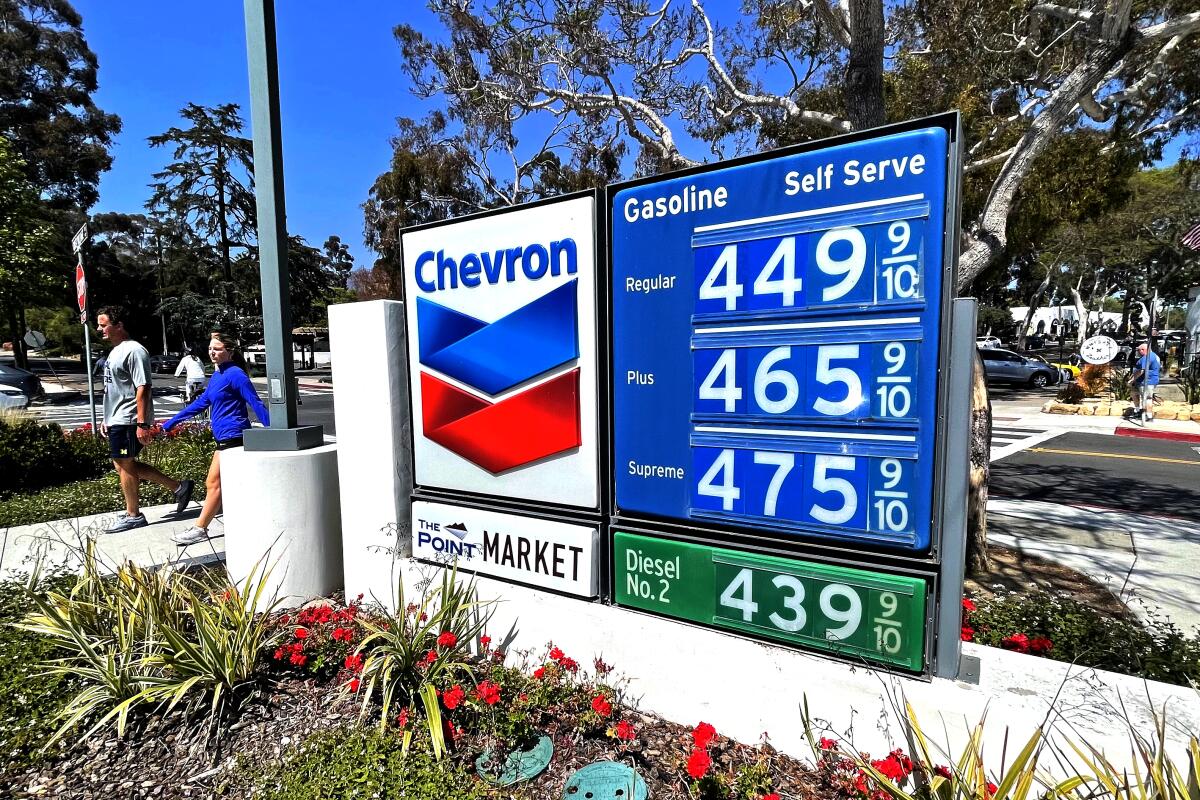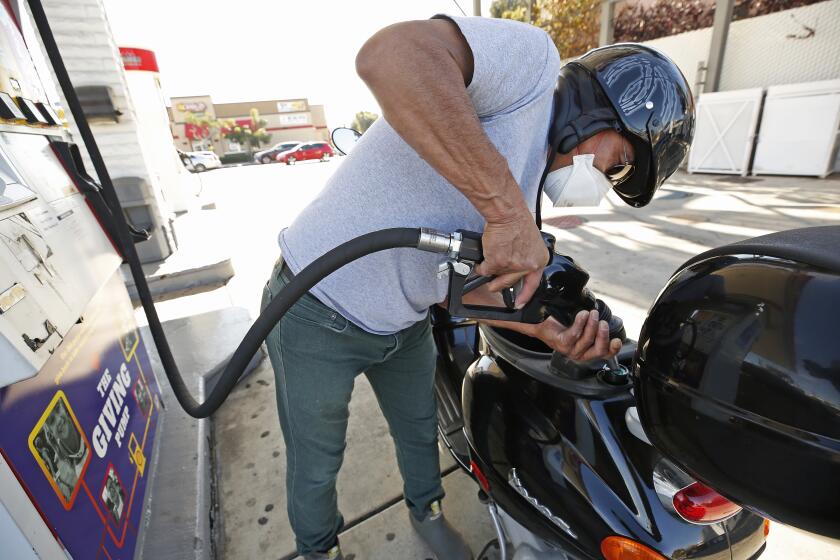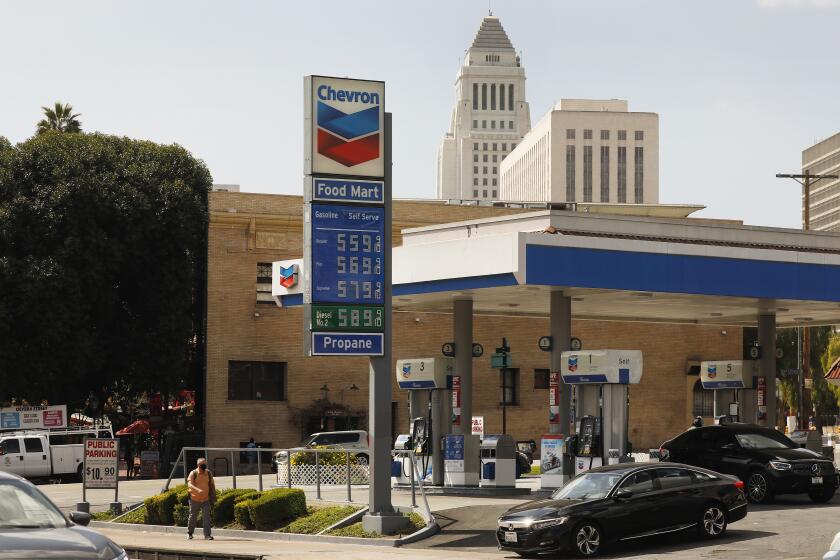How the California and U.S. economies may suffer from Russia’s attack on Ukraine

- Share via
Russia’s attack on Ukraine comes at a vulnerable time for economies around the world. Inflation is already at a worrisome level, consumers are paying more for basic goods across the board, and the global supply chain is still recovering from pandemic disruptions.
The invasion, which has upended geopolitics and threatens a humanitarian crisis in Ukraine, put stocks on a roller coaster and sent the price of wheat, oil and other commodities higher Thursday. Here, we answer some questions on how this might continue to play out for the economy and what this means for consumers in the U.S. and California.
Will food and gas prices in the U.S. rise?
Russia and Ukraine are major producers of a range of commodities — oil, natural gas, grains, metals — whose prices rise during big global events such as war. Those higher prices eventually ripple to grocery stores and the gas pump, and this conflict is no different.
“It is the American middle and working classes that will bear the burden of adjustment caused by another European war,” said Joseph Brusuelas, chief economist at the accounting firm RSM.
The U.S. imports relatively little from Russia directly, but what happens there and in Europe has wide knock-on effects.
Russia is the world’s second-biggest natural gas producer, behind the U.S., and it is among the top three in oil production, along with the U.S. and Saudi Arabia, supplying about 10% of what’s consumed worldwide. (Higher oil prices in global markets translate directly to higher prices at your gas station — gasoline is one of many products made from crude oil.)
Russia is also a major producer of wheat, palladium — used in catalytic converters to clean car exhaust fumes — and nickel. Ukraine is a major exporter of corn and wheat, and a key route for the flow of Russian natural gas to Europe.
Gasoline prices depend on global supply and demand, which has been out of whack since the pandemic started. California drivers pay a premium for special blends.
Broadly, two scenarios could contribute to sending prices on this range of commodities even higher:
- More supply-chain disruptions, affecting the distribution of gas and wheat across Europe, for example. Russian cyberattacks, which some experts predict may now become more frequent, could also worsen problems with global supply chains. That would drive food prices up.
- Sanctions on Russia by the U.S. and allies, mainly those on Russian oil exports, could squeeze markets even more and drive oil prices higher. The Biden administration has not moved to sanction Russian oil. President Biden on Thursday announced new sanctions against Russian banks and said the U.S. would block high-tech exports to Russia.
Europe is a much bigger consumer of Russian oil than the U.S., but sanctions on Russia’s output would ripple through the global market, said Dean Foreman, chief economist at the American Petroleum Institute. Already, oil prices are high partly because there is not enough supply to meet global demand.
“Any significant disruption to that would have to be made up somewhere else,” he said, adding that the tight market would have trouble finding a replacement.
A woman reacts as she stands in front of a house burning after being shelled in the city of Irpin.
Oil prices on both sides of the Atlantic jumped toward or above $100 a barrel — their highest levels since 2014 — earlier Thursday. They then gave back much of the gains after Biden made clear sanctions were designed not to disrupt energy markets, and the steps he announced were less sweeping than some expected.
The price of U.S. oil settled at $92.81 on Thursday, up 71 cents for the day. The spot price for natural gas in Europe, which relies on Russia for the fuel, jumped more than 50%.
Wholesale prices shot up for heating oil, wheat, corn and other commodities.
What else might get more expensive?
Your COVID-19 test kits, your Amazon order, your lip balm — and more.
Petrochemicals derived from crude oil and natural gas are used to make a range of medical and personal care products as well as packaging materials. Huge demand for these products is one of the factors that drove oil prices higher in the pandemic to start with: millions of COVID test kits, a surge in online shopping and all the packaging and delivery truck fuel associated with that.
The demand for petrochemicals used in medical products and packaging rose to the highest level since 1965, according to the petroleum institute. The demand for truck fuel was significantly higher than its pre-pandemic level as well.
A spokesperson for the Plastics Industry Assn. noted that Russian exports provide just a fraction of the oil and natural gas used to create the feedstock for U.S. plastics and other products. But the war in Ukraine and global sanctions on Russia could affect prices for those goods by shifting available supplies; for example, exports of U.S. liquid natural gas — used to make some plastic products — to Europe have increased significantly to offset the loss of Russian natural gas, the spokesperson wrote in an email.
What can we expect to see in California?
Californians could feel the bite of higher crude prices even more. Gas prices here are well above those in the rest of the country — the current average price in the state, about $4.77 a gallon, is about $1.20 more than Thursday’s U.S. average, according to AAA.
California doesn’t import any oil from Russia. As of 2020, the state brought in 24% of its oil from Ecuador, 23% from Saudi Arabia and 20% from Iraq, according to the California Energy Commission.
Still, the absence of a major exporter such as Russia would increase global demand for oil from other countries, which could affect the retail price in California. The state has become increasingly dependent on oil imports as it attempts to move away from fracking, making it increasingly vulnerable to external price swings.
Higher energy costs typically also affect agricultural production, a big part of the state economy, by crimping crop yields and raising prices on produce that are passed on to customers. Economists said it was too soon to see these effects on California farms, though another factor looms: a fertilizer shortage.
Russia is a major global producer of fertilizers, which are already at record-high prices, and turbulence in the region will threaten their supply and raise prices even more.
Another area of particular vulnerability: cybersecurity, especially in Silicon Valley, Hollywood and at the ports.
“Between Los Angeles’ content, and Silicon Valley and Seattle which control software, those are places of vulnerability,” said Jonathan Aronson, a professor of international relations and communication at the USC Annenberg School for Communication and Journalism. “People get paranoid about who’s watching you and when. That’s a place where some trouble could break out.”
The Port of Los Angeles has already been preparing for higher cybersecurity threats, Executive Director Gene Seroka said.
“We are prepared for more activity in the cyberthreatscape, and that’s why we’re working with every expert we have,” Seroka said. “These times are extremely uncertain, and we must be overprepared.”
The L.A. port sees more than 40 million cyberintrusion attempts a month, more than double the number of attempts before the pandemic, he said. Officials there have been working closely with local, state and federal law enforcement agencies to guard against these types of threats, particularly those that could disrupt the flow of cargo.
Will sanctions on Russia affect California trade?
Russia is not among California’s top export markets, and it’s too soon to say how trade flows will be affected, local officials and experts said. The U.S. Commerce Department announced export controls meant to restrict Russia’s access to technology, primarily in the defense, aerospace and maritime sectors.
“It feels a bit premature,” said Susanne T. Stirling, vice president of international affairs at the California Chamber of Commerce. But looking at California’s trade with Russia can give clues.
Out of about $175 billion in California exports to foreign markets, approximately $400 million worth of goods are sold to Russia each year. A quarter of exports to Russia are computer and electronic products. Chemicals, manufactured commodities and machinery are other large exports to Russia.
What does this all mean for inflation?
Economists worry that higher food and energy prices could push inflation into double digits. U.S. inflation last month hit its highest level in a couple of generations, and higher consumer prices now could raise expectations of high prices for months and years to come.
The consumer inflation rate in January surged to 7.5% compared with a year earlier, well above the 5.7% average wage gain for most workers in the same 12-month period.
Even before the latest crisis, the Federal Reserve was poised to raise interest rates to combat surging inflation that, by some measures, has helped make consumers feel as gloomy as they did during the Great Recession of 2008-09.
What worries some economists is not just the potential for higher oil and gas prices, but that this often portends a boom-and-bust cycle that is bad overall for the economy.
“Throughout the history of the oil world, you have the geopolitical conflict,” said Amy Myers Jaffe, research professor at the Fletcher School at Tufts University. “It brings an unbelievable height to the price of oil over and over again, and it’s always followed by an economic crisis that brings a collapse in the price of oil.”
Russian President Vladimir Putin’s advances in Ukraine have put President Biden and the U.S. economy between a rock and a hard place.
What about the stock market?
Stocks initially tumbled around the world Thursday, as fears of a wider conflict and higher inflation rattled investors. U.S. markets then ended the day higher, with tech stocks making a particularly strong rebound.
The tech-focused Nasdaq composite closed the day up 3.3%, and the Standard & Poor’s 500 rose 1.5%.
The rebound came after Biden said he wants to limit the economic ripple effects on Americans and announced new sanctions against Russia that did not go as far as some expected.
Some analysts had expected the conflict to push investors out of many tech stocks, with the exception of the cybersecurity sector.
Concern is growing that “massive cyberwarfare could be on the near-term horizon, which would certainly catalyze an increase in spending around preventing sophisticated Russian-based cyberattacks,” analysts with Wedbush Securities wrote in a note to clients.
The Associated Press and Bloomberg contributed to this report.
The average price for regular gas set a new California record of $4.74 a gallon. Here’s why prices are expected to surge even more.
More to Read
Inside the business of entertainment
The Wide Shot brings you news, analysis and insights on everything from streaming wars to production — and what it all means for the future.
You may occasionally receive promotional content from the Los Angeles Times.


















